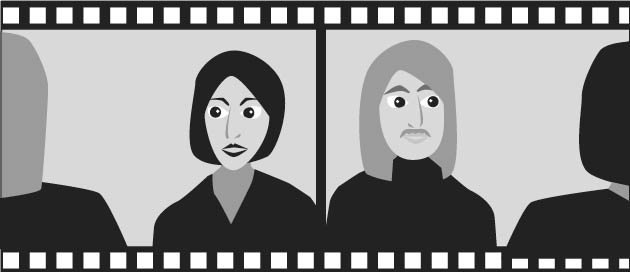Audio-visual or “video” expression consists fundamentally of continuous photographs and the associated sound, which can be either recorded at the site or combined with the footage afterwards. This is why many guidelines that have to do with photography also apply to videography, or “cinematography” as it is called in a film-making context.
Some differences and special characteristics do exist, however. They mostly concern the nature of videography as the recording of time and movement, the simultaneous recording of sound and the combination of material, which is called editing.
In its most simple form, video footage can be shot by placing the camera on a tripod and pressing the rec button. The end-result produced is also referred to as the “static camera shot”.
Professional audio-visual expression requires different framings and types of shots, both close-ups and wider ones.
Framings, perspectives and movements of the camera
 Nevertheless, professional audio-visual expression requires different framings and types of shots, both close-ups and wider ones. A full-frame image shows the viewer where the event takes place.
Nevertheless, professional audio-visual expression requires different framings and types of shots, both close-ups and wider ones. A full-frame image shows the viewer where the event takes place.
Wide shots also give the viewer an idea of how things in the imaged space relate to each other and how they move.
Wide shots lack the definition to show detail and the expressions on people’s faces. For these uses, more restricted framings are needed such as half-frames and close-ups.
Extreme close-ups can force the viewer to focus on a detail, which is important to the narrative.
In its most simple form, video footage can be shot by placing the camera on a tripod and by pressing the rec button. The produced end result is also referred as static camera shot.
To make the footage livelier, the camera is often moved around. The most common manoeuvres of the camera have their distinct names:
Zooming refers to the technique of changing the focal length of the camera while shooting. In some cameras this is done automatically by pushing a certain zoom button. Zooming while recording is very common in amateur home videos, but it is more rarely seen in professional TV camerawork and classical cinematography. Nevertheless, zooming may be used in pseudo-documentaries and mockumentaries as well as in art cinema, precisely because it gives the material an amateurish feel. As different lenses refract light in different ways, it is preferable to move the camera closer to the object instead of zooming or changing the lens when shifting from a wide shot to a close-up. If the lens were to be changed, the end results with two different lenses might look different in the editing phase.
Panning means the movement of the camera in which the camera remains stationary but rotates around its vertical axis, in a horizontal direction, left or right. Tilting means the vertical movement of a camera, where the camera remains stationary but rotates around its horizontal axis, upwards or downwards.
A tracking shot means that the camera moves while recording. In tracking shots, the whole apparatus moves and this is how it differs from zooming. The camera may, for example, be placed on a trolley and follow a person or a car. A common concern regarding tracking shots is how to prevent the image from shaking during the shoot. The technology of hand-held stabilising gimbals has improved drastically in the last 20 years or so, but many creative solutions such as using a skateboard, wheelchair or pushchair as a trolley can help achieve the desired outcome.
Often, multiple shots of the same scene are recorded from different perspectives to provide material for editing:
The master shot means a wide shot that covers the whole scene timewise, and all of its events. In addition to the master shot, smaller framings are used to record details of what is happening. In the post-production phase, these shots can be added to break the monotony of the master shot, hence their nickname “cutaway shots”.
Reverse shots follow the discussion or other interaction between people. It is recommended to frame reverse shots similarly, considering the perspective and the scale as this portrays the subjects on a neutral and equal standing. The positions in which the people stand in the master shot should be kept constant. If the positions change or the people move around, the movement should always be shown in a wider framing, so that the viewer does not get confused. Over-the-shoulder shots are called external reverse shots. Internal reverse shots show each of the people by themselves, with just the direction of their gaze connecting them. The camera is outside the ring formed by the performer.

Reverse shot structure is a much-used practice, both in fiction and documentary cinema and in audio-visual journalism. It is easy for the editor to cut into the opposite reverse shot. This technique allows the editor to lengthen or shorten the event, remove unwanted passages and build a consistent whole from inconsistent shots, while retaining the illusion of a natural progression of events.




